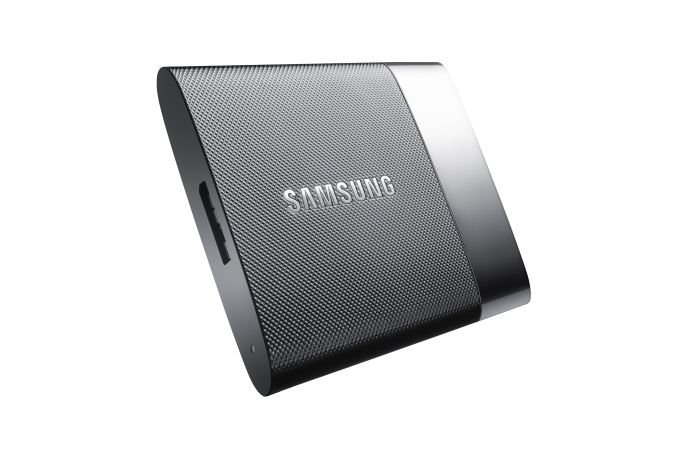Samsung Releases External T1 SSD
by Kristian Vättö on January 5, 2015 5:00 PM EST
Traditionally the external flash storage space has been run by so called second tier OEMs that basically just buy the controller and NAND from third parties and then do the chassis design and assembly on their own. With the introduction of the T1, Samsung becomes the first tier one manufacturer to enter the external SSD market. Hardware wise the T1 is based on the 850 EVO, meaning that the T1 uses 32-layer TLC V-NAND and the same full-fledged MEX/MGX SSD controller. The housing is considerably smaller than a regular 2.5" chassis, though, making the T1 a very portably solution (although a USB stick would be even more portable, but fitting and cooling a full SSD controller in such design is fairly difficult).
The T1 support USB 3.0 UASP mode for increased performance and for sequential performance Samsung is promising up to 450MB/s. Random performance comes in at 8K IOPS for read and 21K for write. There is also AES-256 encryption support, which is definitely handy for business users that handle sensitive data. The drive comes pre-formatted as exFAT to ensure out-of-the-box compatibility with both Windows and OS X based systems.
The available capacities will be 250GB, 500GB and 1TB with the MSRPs being $180, $300 and $600 respectively and a 3-year warranty. The pricing is definitely a bit high, but since we are dealing with MSRPs things can change very quickly and I wouldn't draw any final conclusions yet. I have samples waiting for me when I get back, so stay tuned for our review in the next few weeks.










22 Comments
View All Comments
name99 - Tuesday, January 6, 2015 - link
Samsung Magician? So basically useless for OSX?Fine marketing plan there, Samsung. Apple users may be a small fraction of the PC market, but they are the fraction that spends the most money. I don't expect many control process PCs or cash registers would want to buy one of these SSDs, but plenty of MacBook users might...
gohanrocs12 - Tuesday, January 6, 2015 - link
Blame Apple. They're the ones who don't allow SSD manufacturers to make programs for their SSDs available on Mac.name99 - Tuesday, January 6, 2015 - link
WTF are you talking about?(And Samsung WERE able to make their SW for fixing the EV840 bug available on OSX, albeit with a pretty awful UI. I assume that was done because they were afraid of lawsuits if they did not provide it.)
gohanrocs12 - Tuesday, January 20, 2015 - link
from: http://www.cindori.org/trim-enabler-and-yosemite/"Have you ever wondered why disk manufacturers like Corsair, Samsung etc. have never written a Trim driver for OS X? Or why they never offer firmware update software to OS X? (The only firmware updates they offer for Mac is a MS-DOS boot CD)
The reason is that Apple is keeping the AHCI driver private, making it impossible for anyone, even these big companies, to create a driver for SSD’s.
So the issue is not that Apple “doesn’t allow Trim Enabler”, but that they don’t allow anyone to create AHCI drivers."
LALLALALALA - Monday, January 5, 2015 - link
Will it work with phones? when using otg.baii9 - Monday, January 5, 2015 - link
don't seem to be a problem, just tested a msata and some 2.5 and they all reorganize.will depend on phone and drive i guess.
Impulses - Tuesday, January 6, 2015 - link
Probably, tho most phones (if not all) will never write or read from it fast enough to warrant the cost... But if you have a usage case where you share big blocks of data between phone/tablet and desktop often and a 64-128GB thumb drive just won't do, then this might be the ticket.I could see someone living off something like a Surface loving this thing, question is whether there's any advantage to it vs a regular 2.5" SSD in a USB 3.0 enclosure (beyond the somewhat smaller form factor).
hrrmph - Tuesday, January 6, 2015 - link
In spite of all the other uses for it, it's most useful for people who use thumbdrives as primary storage.If you find the typical high-end 256GB thumbdrives to have insufficient capacity for use as primary storage, then this Samsung SSD looks like a pretty good alternative. This is mostly because it is the first drive of its type to have a truly pocketable size and to offer 1TB capacities without costing $1K.
With the Samsung T1, you get 1TB in a minuscule package at 71 x 53 x 10mm / 2.8 x 2.1 x 0.4". That is far more portable than any 2.5" drive of similar capacity.
I recently bought a 1TB Samsung bare M-SATA SSD and paired it up with an M-SATA to USB 3.0 adapter that lets you physically mount the SSD to the PCB. The PCB lets me plug my SSD into a USB port just as I would with a thumbdrive. The total cost was $425. It works well, thus achieving the same thing as Samsung's new T1 SSD, for $175 less.
I had planned to put some heat-shrink tubing on it to protect my Do-It-Yourself device, but I haven't gotten to doing that yet.
Once the Samsung T1 SSD comes down in price, it will be a cost effective alternative to the DIY route. Plus, it has better physical protection for the electronics inside the case.
Aside from price, the main difference between the Samsung T1 SSD and my DIY solution is that the T1 requires a cable to connect. I would prefer to see a variant offered with a Type A USB connector and a cap on the end of it.
Laxaa - Tuesday, January 6, 2015 - link
But no USB type-C connector. Not on this and not on the slim Segate one.Spuke - Tuesday, January 6, 2015 - link
Yes! Been waiting for something like this.